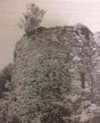Tours of Rait Castle
In another series on Old Castles a few years later, the Inverness Courier for Friday 9 October 1896 published 'No. VI, Rait Castle', Nairnshire with an etching of the Castle at the top of the article. The article was proceeded by an ad in The Inverness Courier for Tuesday 6 October 1896 which stated "Rait Castle, Nairn. - for View and Sketch of this Castle see Courier of Friday week." The lengthy text of the article is as follows: "The ruins of Rait Castle, Nairnshire, have been a source of no little interest and speculation to archaeologists. The building stands about three miles from the town, on an elevated plateau at the foot of Ord Hill. It can be seen from the outskirts of Nairn, although on account of its dark colour against the background of the hill, it does not readily attract the eye. The building consists of a round tower and hall, and forms a massive and picturesque ruin. Archaeologists are inclined to believe that it was erected in the fifteenth century. On the other hand, it is known that there was a Castle on the spot in the thirteenth century belonging to a family which took the name of Raite. No doubt this early Castle may have been destroyed by Bruce in accordance with his fixed policy of demolishing every stronghold that was likely to prove of service to an enemy. As the Raites were on the side of Edward in the War of Independence, and may have belonged to the great house of Comyn, King Robert would have taken pleasure in levelling it to the ground.
In 1291 the Royal Castles of Scotland were delivered into the hands of Edward I, who began his intervention in the affairs of Scotland by acting as arbiter between the conflicting claimants to the Crown. Thomas Braytoft was placed in command of the garrisons at Nairn and Cromarty, but he had to render his accounts through the Knights of Raite. A receipt in his name, granted to Sir Gervaise de Raite, runs as follows: - "To all who may see or hear of these present, I, Thomas de Braytoft, Keeper of the Castles of Nairn and Cromarty, on behalf of the illustrious King, Lord Edward, by the grace of God, King of England, constituted Overlord of Scotland, greeting. Know all men that I, on Thursday preceding the Feast of Pope Gregory, in the year of our Lord 1292, received by the hands of Sir Gervaise de Raite, Knight, constable of Nairn, as the dues and arrears of the baillieship of Invernairn, for my service and custody of the Castle of Nairn and Cromarty, £11 sterling. In witness whereof I have granted the presents to Sir G. - Given at Raite, day and year aforesaid." A year or two later, when Edward makes his first warlike progress to the North, Sir Gervaise swears fealty to the English King. Then came the insurrection headed by Wallace and young Andrew Moray. There was a gathering of notables in the English interest at Inverness, the centre of the district where serious disturbances first broke out. This conference send another of the Raite family, Sir Andrew, as the bearer of despatches to Edward with an account of what was going on. The Bishop of Aberdeen tells Edward of the outbreak of Andrew Moray, and adds - "It would be too long a business to write, but we pray you to give credence to Sir Andrew de Raite, your bachelor, who can tell you these affairs in all points, for he was a person in all these doings." The same messenger carried letters from the Countess of Rose and the Earl of Stratherne, and on his way South had an interview with Cressingham, the King's Chamberlain. The latter, however, did not take the matter as seriously as might be imagined. Writing privately to Edward, he says - "Sir Andrew Raite is going to you with a credence which he has shown me, and which is false in many points and obscure, as will be shown hereafter as I fear; and therefore sire, if it be your pleasure, you will give little weight to it." The battle of Stirling Bridge and the death of Cressingham furnished the commentary to this opinion. The fate of Sir Andrew de Raite is unknown. When the War of Independence is at an end, the Thane of Cawdor becomes Constable of the Castle of Nairn.
Although the Raites fell from their important position, the family seems to have lingered for some time in the district. Shaw, the historian of Moray, says that about the year 1404 Raite was banished the county of Nairn, in consequence of his having killed Andrew, Thane of Cawdor, and that he settled in the Mearns, where he founded the family of Raite of Halgreen. It is likely enough that a feud existed between the Raites and the Cawdors, on account of the thanes having supplanted their rivals in the office of Constable of the Castle of Nairn. There was an Andrew, Thane of Cawdor, about the time mentioned, as official record exists of his son Donald having succeded to his lands and offices in 1405. Shortly afterwards we discover that the lands of Rait have been divided. There is a precept of seizin, dated 17th August 1442, by Alexander, Earl of Ross, in favour of William of Cawdor, as heir to his father of various lands, including....."the half lands of Rait". The Castle, however, was not on this portion of the property. We learn from subsequent documents that it was connected with the other half, a portion which generally appears associated in the charters with the lands of Meikle Geddes.
Our interest therefore centres in the second "half" of the lands of Raite. Mr Fraser-Mackintosh says that Alexander Lord Gordon, on 5th October 1442, granted a charter to Mackintosh of the lands of Raite and Meikle Geddes, which charter, he says, is still extant. The grant, however, never seems to have taken effect. The lands were in the possession of Alexander Seton of Tulliebody in 1493, as we find him in that year granting them to William Thane of Cawdor to be held by him in feu-farm; reddendo, £20. It is a curious circumstance that one of the witnesses to the charter is a "Johanne Reyth", possibly a descendant of the old family....... At length, in 1532, Sir John Campbell of Cawdor purchased from Joh Ogilvy of Carnousie "all and haill his landis of Mykill Geddes and Half Rait with their pertenance,".... In 1555 Alexander Ogilvy of Doorn, "superior of the landis of Geddes and Rait, with the fortalice ? in the ?"..... Finally, in 1596, we find John Campbell of Cawdor served heir to his grandmother Muriel, to his grandfather, his father, and other relatives, of all the ;ands "holden immediatelie of the King"; and these now include all the lands of Geddes and Rait, with the fortalice of Rait. It will be seen that the Castle is rarely referred to in the documents relating to transactions with Cawdor. It is not, however, spoken of as a ruin. It may have been so, but in that case one would expect to find some qualifying word.....
During Muriel's residence in Argyll her uncle, a very ferocious man, was guilty of various acts of robbery and murder..... At last he was outlawed, and a reward offered to any person that would take him dead or alive. In the course of his rounds, he came down the shoulder of the Hill of Urchany by the Castle of Rait, and concealed himself behind a large stone near the water dam there, when a man near the place observed him looking over the stone; and the man having a loaded gun, shot him in the forehead, the only part that was visible of him above the stone; hence the stone is called Calder's stone to this day. And after his death, Muriel and her husband got quiet and peaceable possession of the property.
The authentic notices of the Castle, as we have said, are few in number, and contain little information. There is, however, a remarkable and very interesting legend told in Mr Bain's admirable History of Nairnshire. The legend is based on the assumption that the Raites were Cummings, and were at feud with the Mckintoshes. Mr Bain's version of the legend is as follows: - "The story is to the effect that Cuming of Raite, under the guise of a desire to bury former animosities and establish friendly relations, invited the Mackintosh and his followers to a grand banquet at Raite. The invitation was accepted, and the Clan Chattan, nothing doubting prepared to attend. They were, however, timely warned that the Cumings in this had planned a foul plot, and that at a given signal each Cuming would rise and slay his defenceless guest. Old Cuming had put all his household under a solemn oath that they would not reveal the plot to any person, but his daughter, anxious for the safety of young Mackintosh, who was her lover, found a way to disclose the plot. She went to a large boulder some distance from the Castle, and told the whole story to the stone, but she knew her lover was behind it, as it was their usual trysting-place, and he would hear every word. The stone to this day is called 'The Stone of the Maiden.' The Mackintoshes, notwithstanding the warning, resolved to attend the feast. When the night of the banquet came, each Mackintosh hid his dirk in his plaid, but gaily took his seat around the festive board of Cuming of Raite. The revelry ran high, and the walls of the old Castle resounded with the mirthful shouts of the carousers. At length the toast is given 'The Memory of the Dead.' This was the signal agreed upon for the slaughter of the guests. The Cumings rose and were about o draw their swords, but the Mackintoshes being forewarned were forearmed, and with a yell of derision sprang to their feet, drew their daggers and thrust them into the hearts of the Cumings. Among the few that escaped death, it is said, was the chief of the Cumings, who flew to an upper chamber, where his daughter was, whom he believed to have given the Mackintoshes the information, as he knew the girl and young Mackintosh were lovers. Seeing the maddened state of her father, she sought to escape from him by leaping out at the window, but before she could do so het cut off bother her arms with a broad-sword. From the night in which the tragedy was enacted the blood-stained walls of Raite have been tenantless. So runs the tradition.
A story of the same sort is told in connection with Raites in Badenoch. Such a bloody tragedy might have happened at either place. If it occurred at Raites in Nairnshire it must have been before the lands came into the hands of Alexander Seton in Tulliebody.
Raite Castle is called by Messrs Macgibbon and Rose an "interesting and almost unique building." The only buildings in Scotland which resemble it are Morton Castle in Nithsdale and Tullyallan Castle near Kincardine, on the Forth. The architectural features of the three suggest the first half of the fifteenth century as the date of their erection. If this conjecture be correct, the Castle may have been erected about the same time as old Darnaway Castle (of which the hall alone remains), and the Castles of Cawdor and Kilravock. Darnaway Castle was begun by one of the Douglases, at the time when the family was forming their great conspiracy against James II. Raites Castle may be a relic of the same movement. Morton Castle, which it is said to resemble, belonged to a branch of the house of Douglas."
A year or so later, Nairnshire Mirror, and General Advertiser for 8 December 1851. Under the heading 'Nairn and Nairnshire', which describes various sites and scenery and places to visit, there is mention of Rait Castle - “The ruins of the chapel only remain. Once a seat of a branch of the Mackintoshes, and afterwards of a chief of the family of Comym; belonging thereafter to a Rait of that Ilk, then to the Ogilvies of Carnousie, and purchased in 1523 by the founder of the present family of Cawdor, in whose hands in still remains.”
There is a visit report in the Nairnshire Telegraph and General Advertiser for the Northern Counties for 31 August 1854 to the Barony of Cawdor which provides the backstory behind Rait Castle. “We also visited the parish school…. On the east end and on the confines of the Cawdor property stands the ruins of the Castle of Rait, a stronghold of the Cummings in the ‘days of yore’. where a barbarous feud took place between them and the Mackintoshes. On one occasion the chief of the latter clan and a number of his leading clansmen were invited by the Cummings to a banquet. The real object, however, was to massacre the chief of Clan Chattan and his followers, and this deed was to be perpetrated whenever a bullock’s head was taken to the banqueting table, around which the Mackintoshes were to be seated, each between two Cummings. This had been arranged the previous day between Cumming and his clansmen, who had solemnly sworn not to divulge the design lest it should reach the ear of Macintosh. However, the family fool overheard all, and on the forenoon of the fatal day proceeded to meet the Macintoshes, and after travelling to Dalgarmich - nearly eight miles westward - he stood close to a large pyrimid [sic] stone. Here he plainly saw the Macintoshes coming in the distance, in great haste, as as they came close to him he turned his face to the moss-covered obelisk and addressed it in their hearing as follows: - "This evening when the bullock’s head comes to the dinner table at Castle Rait, the Mackintoshes will be slain, none returning to tell the tale. Oh yes! oh yes! the poor Mackintoshes, mind that". Whilst the idiot was thus addressing the inanimate stone, the Mackintoshes stood silently hearing this exposition of the treachery of their pretended friends; but they nevertheless resolved to go to the banquet, and that whenever they should observe the bullock’s head brought forward - taking it for granted that all was true - instantly to thrust their dirks into the sides of the Cummings.
At length they arrived at Castle Rait, where seemingly they received the greatest coustesy [sic] and kindness from Cumming and his men. Soon thereafter the dinner was served, and the Mackintoshes took their seats at the table just as previous arranged. All went on well, the shrill notes of the pibroch outside sounding in their ears. The dinner was now nearly finished, the hall-door was slowly opened and a ghastly looking figure appeared, entering with a bullock’s head in a charger. In an instant the Mackintoshes, who had their drawn dirks concealed in the plaids, thrust them into the sides of the Cummings, and with such effect that most of them were killed on the spot. Among those who escaped death was the chief, who flew to an upper chamber where was his daughter, whom he believed to have given the Mackintoshes the information, as he knew the girl and the younger Macintosh were warmly attached to each other. Seeing the maddened state of her father, she hastened to one of the windows in order to leap out, but before she could do so he cut off both her arms with a broad-sword. The Mackintosh and his men escaped scathless, but had it not been for the forewarning of the fool, there would have been quite a different catastrophe.
It is said the Cumming family were always anxious to possession of certain lands in Badenoch, belonging to the Mackintoshes, and the only way of doing so was to get rid of the chief and his leading clansmen, believing if this were once done there would be no barrier in the way of their taking possession of the said lands. The treacherous act of the Cummings at Castle Rait, in the days when might was right, gave rise to the Gaelic proverb, common in the highlands to this day: -
'‘Fhad ‘sa bhios craobh ‘sa choill
Cha bhi Cuimeanach gun fhoill."
or
"While in the wood there is a tree
A Cumming will deceitful be."
No doubt, the proverb meant the Cummings of the days in which it was made; and even then, it was most unjust to saddle a whole clan with the misdeeds of a heartless chief and a few followers. However, such are now merely mentioned among the things that were. - Mac-an-t-Seanachaidh.”
On Friday 6 June 1862, Dr Grigor [President of the Nairn Literary and Scientific Institute] delivered a lecture 'About the Town and County of Nairn in Olden Times' in the Congregational Chapel, in aid of the funds for the Museum. His lecture is printed in the Nairnshire Telegraph and General Advertiser for the Northern Counties for Wednesday 11 June 1862. "In his remarks about antiquities he discusses and shows relics peculiar to the period, including “stone celts - used as sharp edged tools - hard as iron nearly, and of a wonderful polish for that day. This very fine specimen was found near the old Castle of Rait….” Later in the lecture Dr Grigor says “We then step on to view that interesting period when Edward I attempted to unite Scotland with England, and in the year 1291. I find that the castle of Nairn, along with 22 other fortresses, was formally delivered over to that monarch, and committed to the charge of his own English officers, and garrison by his own troops. The castle or fortress here alluded to was built by King William, surnamed the Lion, about the year 1280, and stood on the west bank of the river, on the site still distinguished by the name of the constabulary garden, having the river on the south, and surrounded with high walls. Nairn was constituted a Sheriffdom by William the Lion, and I find that the office of Sheriff of Nairn in the 13th century created him also keeper of this castle….. He then mentions the De Moravia family as well as that of Sheriff Reginald le Chen or Cheyne, a family of Anglo-Norman lineage, who came over with William the Conqueror in quest of better fortunes - and who, like so many others, swore fealty to Edward in 1296. “These gentlemen were succeeded in the command of [i.e Nairn] castle by the Thanes of Cawdor, who then held it hereditarily till the jurisdiction act in 1747….. At the Parliament at Berwick in the year 1292, amongst those present from the north of Scotland, we find again Sir Reginald Le Chen, Sir Jervais de Raite and Sir Andrew de Raite, from the County of Nairn and this is the first notice of the family of Raite that I have observed. The Parliament met to hear the award of the King, which was that John Baliol was the nearest heir and entitled to succeed to the crown of Scotland; and amongst many letters written I find one to Thomas de Braytoft, governor of the Castles of Nairn and Cromarty, and to William de Braytoft governor of the Castle of Inverness and Dingwall, to deliver up their castles to King Baliol….."
Dr Grigor’s lecture was continued in the Nairnshire Telegraph and General Advertiser for the Northern Counties for 25 June 1862 and in this part there is a lengthy section devoted to Rait Castle or Fortalice. “Before leaving the neighbourhood of Geddes, let me look at that grey, solid, yet time-worn looking mass, the old castle of Rait. Mark the thickness and almost vitrified appearance of its walls; see the opening for the portcullis at the gateway, which is at drawbridge height. Curious, to built it on the bare out-cropping primary rock, yet, perhaps a test of its years and the age in which it was built, all tending to strength and endurance. We know very little of the history of this ruin. In one of the Kilravock charters we find notice of the chapel of Rait, the foundation of which, it is said, is as old as the reign of William the Lion, and also of the hermit of Rait. Shaw tells us that Rait belonged at a very early period to a Rait of that Ilk, and you know that one of that name was a witness, along with Hugo de Roos de Geddes and Donald of Calder, in the year 1260. That one of the family of Rait killed Andrew, Thane of Calder, about the year 1404, and was banished the district, but afterwards founded the family of Halgreen in the Mearns. It then seems to have been possessed by the Cumines of Raites; and I cannot pass over the story of chivalry and romance told by the late Sir Thos. Dick Lauder in his ‘Moray Floods’.
It is designed "The fight of the lost standard" between Randolph and Cumin of Raites. The latter had gone, with numerous followers, to assist his kinsman, Cumin of Inverlochy, in a feud. They were on the eve of a great battle, when a hot-posted messenger arrived to tell Raites that Randolph was preparing for hostilities against him, and earnestly urging his immediate return. "With the help of God", said Raites, "I will fight this battle and that too!". Fortune was unpropitious; they were defeated, and the chief of Inverlochy was slain. Raites snatched up a spear ere he quitted the field, broke it, and besmeared it and his battleaxe with the blood of his dying relation; and on his return, he sent this ensanguined fiery cross, surmounting his battleaxe, through the clan, as an imperative summons to war. The pace of meeting was Cairnbar, the hill between Lethen and Coulmony. The private password was “Live or die like a Cumin.” The beacons of the country blazed forth; the clansmen hurried to Cairnbar’ they marched to surprise Randolph at Tarnaway; but Randolph, aware of their movements, suddenly issued from a ravine hear Whitemire, attacked the little army, routed them, and killed the Raites. The remaining Cumines, retreated toward Clune, and fought their way manfully. They fell back on the banks of the Findhorn, and were hard pressed by Randolph on both sides of the river, till at length Randolph, it is said, threw his standard across the river calling, “Let the bravest keep it,” leaped the yawning gulf, which to this day is know as Randolph’s Leap, and soon was in the fastness of the wide extended forest of Darnawa.
The Rait estate, then, seems to be divided into two portions. One-half becomes the property of Thane of Calder in 1442, the other portion that of the Hays of Lochloy; they sell it to John Ogilvie of Carnousie, in Banffshire, from whom Sir John Campbell of Calder purchased it is 1538. It is evident that, in almost all these northern feudal possessions, the original mode of possession was in this way: - On the grant of land being given to the baron, the first thing he did was to build his castle, then his church - which, in many cases, as at Cawdor, afterwards became the parish church - his mill and malting house, dovecot etc. Then the retainers or vassals, who were generally very numerous, and comprehending his artizans [sic], his falconers, forest keeper, and armourers, took up their abodes around it.
[As an aside, it is worth pointing out that the above story might not be totally trustworthy! Darnaway Castle, also known as Tarnaway Castle, is located in Darnaway Forest, three miles southwest of Forres in Moray. This was Comyn land, given to Thomas Randolph along with the Earldom of Moray by King Robert I. The castle has remained the seat of the Earls of Moray ever since. To the south of the castle, where the River Findhorn rushes through a gorge and sheer rocks are on either side, Randolph's Leap commemorates the sort of leap usually associated with Rob Roy MacGregor or the Soldier's Leap at Killiecrankie. It was probably not attempted by Earl Randolph, but by his quarry, Alastair Comyn of nearby Dunphail. According to the legend Thomas Randolph, later Earl of Moray, was pursuing a Comyn, who leaped to the other side and escaped back to his castle. The Comyn castle fell and the lands were granted by King Robert to Randolph. The name gradually changed from Comyn's Leap to Randolph's Leap.]
Dr Grigor continues his story in the same issue of the Nairnshire Telegraph and General Advertiser for the Northern Counties this time under the heading 'Tragedy at Rait Castle'. "Local tradition attaches to this ruin a tragic tale which has no parallel in feudal times. It is this: - And old hatred and rivalry, it is said, existed between the Mackintoshes - the Clan Chattan - and the Comyns, in consequence of some preferment at Court. The Comyns, we are told, had planned a blood-laid scheme, by which the deadly thirst of their vengeance against the Mackintoshes could be fully assuaged, and, under the guise of perpetual oblivion of past animosities, it was arranged that they should invite the Clan Chattan to a lordly banquet at the chief's castle of Rait, and it was agreed on that when the festivity of the banquet was at its height, at a signal given by the chief, which was to be the toast "health to the dead", the Cummings were to draw their swords and fall upon their unprepared guests, not one of whom should be allowed to escape. Due warning had, however, been sent to the chief of the Mackintoshes. The night of the banquet came, and every Mackintosh had hid a dagger in his bosom, and whilst the wassail and the wine went round, and the cheers sounded load, the warning toast was given, whereupon each Comyn started to his legs, and the Mackintoshes, with a laugh of scorn and derision, passed a dagger into every Comyn's heart, and the blood-stained halls of Rait echoed with the wail of the coronach, and were deserted for ever.
In some of the charters of the neighbouring families, mention is made of the Castletown of Rait, the chapel, mill, brewhouse, and so forth.
It surely does seem curious to us, in this day and generation, to reflect on the medley of religion and feudal strife, when "might was right", which must have just been enacted in such places as we have just now seen. Two chapels - no doubt one of them an oratory or domestic chapel - dedicated to the Holy Virgin, and a hermit, almost stone-cast of each other, and from which the orisons of the mass for the souls of the dead of all their friends would arise! It fills us with gratitude to God, to think of the revealed religion, the education, the civilization, and the peace which we now enjoy, and which yield their fruits in the religious, the political, and the free advantages which are vouchsafed to us."
Writing in the Nairnshire Telegraph and General Advertiser for the Northern Counties for 25 November 1863 on the Antiquities of Nairnshire continued, Dr Grigor endeavours “to elucidate the earliest notices of the Thanes of Calder (Cawdor), but the lamp of history does not throw much light on the ground to be traversed. The first authentic note of them is when Donald Thane of Calder, along with William and Thane of Moines and Sir Jervaise de Rait, held valuations of the lands of Geddes in 1295……..The first authentic Thane of Cawdor, then, was Donald, who with other good and faithful men of the country gave their oaths to the valuation of Kilravock and Estir Geddes, the property of his neighbour Hugh Rose, at Nairn, on Wednesday, the feast of St Lawrence, 1295. This, I believe, is the first notice of valuation in Scotland. Then came William, the second Thane, probably a son of Donald. He had a charter from King Robert the Bruce in 1310, in heritage, for 12 merks to be paid in exchequer yearly. It bears also that the lands had been held of the crown in the time of Alexander III. He is succeeded by his son Andrew, who was killed by Sir Alex. Raite of Raite, upon which Thane Donald was served heir to his father. This Thane was, in the year 1406, vested in the offices of Hereditary Sheriff of Nairnshire, and Constable of the Royal Castle of Nairn, in which he lived, his country seat being at Old Calder, about half-a mile to the river side of the present castle, and of which no trace remains…….”
In the Nairnshire Telegraph and General Advertiser for the Northern Counties for 23 June 1869 under the heading 'Places of Interest' the story about Rait Castle, published fifteen years earlier, appears once again - "Little is known of the origin or history of this ruin, which stands at the foot of the Geddes hill. In the beginning of the fourteenth century Rait of that Ilk is concerned in the assassination of the Thane of Cawdor, and the family disappears from this part. The half o' Raits was purchased by the Thane of Cawdor in early times. Of its occupation by the Cummings of Dunphail the following tale is preserved by tradition - "A long and deadly feud existed between the Clan Chattan - the Mackintoshes - and the Cummings. On one occasion, the chief of the Cummings, under the guise of a desire to bury former animosities and establish friendly relations, invited the Mackintosh and his followers to a grand banquet at Rait. The invitation was accepted, and the Clan Chattan, nothing doubting prepared to attend. They were, however, timely warned that the Cummings in this had planned a foul plot, and that at a given signal each Cumming would rise and slay his defenceless guest. The Clan Chattan, however, resolved to attend the feast. When the night of the banquet came, each Mackintosh hid his dirk in his plaid, but gaily took his seat around the festive board of Cumming of Rait. The revelry ran high, and the walls of the old castle resounded with the mirthful shouts of the carousers. At length the door of the hall opens, and the shrill strains of the bagpipe for a moment drown all the noise. A ghastly looking figure the enters with a bullock's head in a charger, and the toast is given "health to the dead." This was the signal agreed upon for the slaughter of the guests. The Cummings rose and were about to draw their swords, but the Mackintoshes being forewarned were forearmed, and with a yell of derision sprang to their feet, drew their daggers and thrust them into the hearts of the Cummings. Among the few that escaped death, it is said, was the chief of the Cummings, who flew to an upper chamber, where was his daughter, whom he believed to have given the Mackintoshes the information, as he knew the girl and young Mackintosh were lovers. Seeing the maddened state of her father, she sought to escape from him by leaping out at the window, but before she could do so het cut off bother her arms with a broad-sword. From the night in which the tragedy was enacted the blood-stained walls of Rait have been tenantless."
The Huntly Express for 2 August 1884 provides a note about the activities of the Northern Literary and Scientific Societies gathering at Nairn the previous Friday [25 July] and discusses in the programme a visit to points of interest in and around the town. The excursions duly too place on the Saturday [27 July] morning at 8 o'clock. "Numbers of brakes and clattering horses, number of men in grey overcoats, a small sprinkling of ladies gaily dressed, a number of unkempt town idlers and curiosity-mongers open-mouthed - all these are to be seen in the vicinity of Leith's Hotel. A short time for arranging seats and stowing away overcoats, and all at once the gay procession, numbering upwards of 100, moves in the direction of Cawdor, with a lively road, fresh horses, and a sunny sky. Shortly after leaving the town Balblair is sighted to our right, and the spot where the Royal army encamped on the eve of the fatal Culloden was pointed out by Dr Grigor. On again - past Geddes House to our left, with Rait Castle behind it on the rising ground - never parting company altogether with the river Nairn. Landwards, the whole aspect of the country is English, abounding in hawthorn and beech hedges, stately elms and spreading beeches, and graceful spruces. But we have time only to admire, not analyse, until we enter the Cawdor grounds."
On 18 February 1888, The Northern Scot and Moray & Nairn Express reported on a lecture on 'Scotch Castles and Local Types' given by Mr H. T. Donaldson, solicitor at the Nairn Literary Institute on Friday 17 February. After discussing various castles, including Cawdor, "The lecturer then proceeded to deal with Rait Castle, of which he gave a very interesting and descriptive account, but said the history of it was almost buried in obscurity. The property belongs to Lord Cawdor, but as far as he remembered, there was no account in the Cawdor charters of how it came into their possession. They were all familiar with the tradition that the castle belonged to the Comyns, and that it was the scene in which their plot to exterminate the Mackintosh ended in their own destruction. The story is a pretty one, but there was no time to relate it, and, besides, many people maintain that the tradition belongs not to this castle, but to the Badenoch castle of the Comyns. Shaw, in his "History of Moray", says that the castle was the seat of the Raits of that Ilk, and there is a tradition that in the year 1404, Sir Andrew Rait murdered the Thane of Cawdor, for which crime he had to flee the country and suffer the loss of his lands. He is said thereafter to have founded a family of Raits in Forfarshire. This tradition, attributed to the year 1404, was so far supported by the fact that there was among the Cawdor charters a precept of Sasine dated in 1482 in favour of William of Calder as heir to his father in several lands, including the half lands of Rait. How the father acquired the lands, however, is unknown. With regard to the ecclesiastical-looking features of the castle, if it could be shown that the unfortunate Laird of Rait had held any office of dignity in the church, then the castle would be quite accounted for.
The Inverness Courier for 17 July 1891 reported the arrangements for holding the Joint Meeting of the Northern Association of Literary and Scientific Associations in Nairn. Society members and friends would assemble for the reading of papers of different subjects of interest on Friday 31 July, followed by conversazione (sic), a reception and musical programme, and on the day after, Saturday 1 August there would be excursions to various places of interest in the neighbourhood, including Rait Castle.
The Northern Scientific Societies duly held their Annual Meeting in Nairn on Friday 31 July 1891 with Dr Cruickshank, President of the Nairn Literary Institute in the chair. The following day, Saturday, as reported in The Inverness Courier for 4 August 1891, "an excursion party, numbering about a hundred, set out for the country, under the leadership of Dr Cruickshank, Mr George Bain, and Mr Finlayson. The first stoppage was at Raites Castle of which Mr Bain gave an admirable description, clearing up at the same time, a disputed point in history. About the time of the struggle with Edward I, two names appear on record, Sir Gervase de Raite, and Sir Andrew de Raite. They seem to have belonged to the great family of Cumyn, but it has always been a question whether they lived at Raite, in Nairnshire, or at a place of the same name, now Belleville, in Badenoch. Mr Bain pointed out a document in the English papers relating to Scotland, which is conclusive on this point. It is a receipt, dated 6 March 1292, given by Thomas de Braytoft, keeper of the Castles of Invernairn and Cromarty, to Sir Gervase de Raite, knight, of the Constabulary of Nairn, for a sun of £11 sterling, received by Braycroft as custodier of the two Castles above named. The receipt is dated "at Rathe" and no doubt the governor had ridden put from Nairn to receive the money from the hand of Sir Gervase. The name of the Castle points to the fact that it was a rath, or stronghold in Celtic times, and has probably been the site of a succession of buildings. The present ruins are a good deal later than the War of Independence."
The Inverness Courier in its issue for 4 August 1893 placed an ad to the effect that "The Publishers have pleasure in announcing that early in August a series of Papers will begin to appear in the Inverness Courier, entitled 'Notes on Old Castles in the North.' These Papers will supply information at present little known or not accessible to the general public." The series began on Tuesday 15 August and the issue of The Inverness Courier for 5 September 1893, No. IV in the series 'The Thirteenth Century' has some information about Rait Castle. "In our present article we propose to make a note of some of those castles which existed prior to the War of Independence, a war which broke out say 1296, and lasted in acute stages, under Wallace and Bruce, for eighteen years. In the Exchequer Rolls of Scotland, and in documents relating to Scotland, preserved in London and elsewhere, there is mention of numerous castles throughout Scotland. In 1292, twenty-three are specified as the great garrisons of the country. In the North we had seven of them, namely...... Nairn...... and amongst others which existed were those of .....Rait.....all on or near the coast of the Moray Firth.
The Scottish castle of the thirteenth century seem to have consisted of an enclosing wall, inside which wooden buildings could, if necessary, be erected....... The Governors appointed by Edward I to take charge of the Castles in his interest are known from public documents, where their names occur in connection either with the payment of receipt of money. Thus in 1291,..... Thomas de Braytoft [was] governor of the Castle of Nairn and Cromarty.... From the same source we learn that Sir Gervase de Rathe was constable at Nairn at the time Thomas de Braytoft was governor of the castle. There is a receipt in which Thomas de Braytoft acknowledges having received £11 from Sir Gervase for the custody of the Castles of Nairn and Cromarty, and the paper is dated at Rathe on 6 March 1292. The extensive ruins of Rathe or Rait Castle still stand within three miles of the town of Nairn. Most of the existing remains are of later date than the thirteenth century, but they doubtless stand on the site of the castel in which Sir Gervase and Braytoft met and transacted their business."
There were still an occasional mention of Rait Castle in the press in the 20th century. Under the headline 'A Week-end Afoot in Moray and Nairn' by F. Campbell in the Aberdeen Press and Journal for 28 March 1932, there is a paragraph headed In Full Song: "We quickly began to descend into more fertile country, and bird life abounded. Even so early in the year, most resident species were in full son, and quite a number of nests were spotted during the week-end. Near Rait Castle we came across further evidence of granite, and the ruins of the castle itself gave us much food for conjecture on what turbulent times must have prevailed in "the good old days"."
A few years later, the Aberdeen Press and Journal for 21 November 1936 reports on the AGM of the Elgin and Morayshire Literary and Scientific Association held the previous evening. Following the business and election of office-bearers, there was a lecture given to members of the Association by Dr Douglas Simpson, Aberdeen University on the history, architectural significance and their outstanding characteristics of Lochangilan and Rait Castles. "Rait Castle, said Dr Simpson, was in every way a most remarkable building. It was an excellent example of the type of castle introduced into Scotland in the latter half of the fourteenth century. Dr Simpson illustrated his lecture with lantern slides."
This lecture by Simpson was obviously based on his recent survey of Rait Castle, which was written up in the Proceedings of the Society of Antiquaries of Scotland 1936-37. In The Scotsman's issue of 16 June 1938 under the heading 'Digging up the Past - Archaeologists' Discoveries', there is a brief overview of papers appearing in that volume of the Society's Proceedings. Under the subheading Nairnshire Ruins it is noted that "there is considerable variety in the remaining contents of the volume. Dr W. Douglas-Simpson discusses two Nairnshire ruins - Rait Castle and Barevan Church. Rait Castle, he observes, is an excellent and early example of the "palace" plan introduced into Scotland in the 14th century."
In an article about Clan Chattan and the Mackintoshes in the Aberdeen Press and Journal for 2 August 1969, there is a paragraph relating to Rait Castle. "The earliest documents among The Mackintosh's monuments is a charter of 1442 establishing "Malcolm McKyntosh" (referred to in later charters as "Lord of Moye" and "Captain of Clan Chatane") as being in possession of Meikle Geddes and Rait Castle. In the next century the Mackintoshes appear as Barons of Moy under the Bishopric of Moray.
The claim to Rait Castle and to the lands of Petty led to a bitter feud and dispute between the Mackintoshes and the Comyns or Cummings, lords of Badenoch; and the famous story is told of how the Cummings, invading Strathdearn, sought to destroy their enemies by damming the waters of Loch Moy so that they would flood the island whereon stood the Mackintosh stronghold."
It was noted in an article about Cawdor in the Aberdeen Press and Journal for 31 July 1976 which mentioned Barevan Church of which "The existing ruin, two miles from Cawdor, is early fourteenth century and was probably built by the masons who also built Rait Castle not far away."
The Aberdeen Press and Journal carried a small item in its issue for 24 April 1982 noting that "Two handsome paperback volumes by Janice Anderson and Edward Swinglehurst describe walks associated with legends first in the Lowland and Eastern Scotland and then in Western Scotland and the Highlands..... Other walks in this volume include one to Rait Castle, near Nairn. The ghost seen here is that of a Cumming maiden who flung herself from a high window of the castle to her death."
Then nearly a hundred and fifty years after the first mention of Rait Castle in the press, the Aberdeen Evening Express announced in its issue of 16 September 1992 that there would be an illustrated talk on Rait Castle at the Village Hall, Cawdor, that night at 7.30pm under the auspices of the Cawdor Heritage Group.
In the Christmas Supplement to The Inverness Courier for Friday 25 December 1896, there is a pictorial of several castles, among them Rait Castle, Nairnshire. There is the same sketch used in the earlier issue of the newspaper accompanied by much of the same text: "The ruins of Rait Castle, Nairnshire, have been a source of no little interest and speculation to archaeologists. The building consists of a round tower and hall, and forms a massive and picturesque ruin. Archaeologists are inclined to believe that it was erected in the fifteenth century. On the other hand, it is known that there was a Castle on the spot in the thirteenth century belonging to a family which took the name of Raite. No doubt this early Castle may have been destroyed by Bruce in accordance with his fixed policy of demolishing every stronghold that was likely to prove of service to an enemy. The Raites were Constables of Nairnshire until after the War of Independence, when the office was conferred on the Thane of Cawdor. The last Raite is said to have been banished from the district in 1404, in consequence of his having slain the Thane of Cawdor. The lands, and probably the Castle, then passed into the handsy of Seton of Tulliebody, who held them for a short time; next we find Ogilvie of Boyne as owner, and finally, in 1532, they were purchased by Sir John Campbell of Cawdor. Raite Castle, as it now exists, is called by Messrs Macgibbon and Rose an "interesting and almost unique building." The only buildings in Scotland which resemble it are Morton Castle in Nithsdale and Tullyallan Castle near Kincardine, on the Forth. The architectural features of the three suggest the first half of the fifteenth century as the date of their erection. If this conjecture be correct, the Castle may have been erected about the same time as old Darnaway Castle (of which the hall alone remains), and the Castles of Cawdor and Kilravock. Darnaway Castle was begun by one of the Douglases, at the time when the family was forming their great conspiracy against James II. Raites Castle may be a relic of the same movement. Morton Castle, which it is said to resemble, belonged to a branch of the house of Douglas.
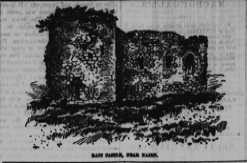
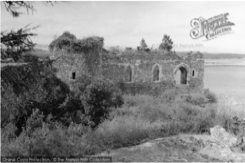
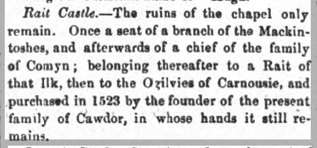
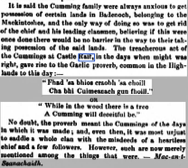
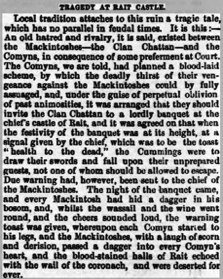

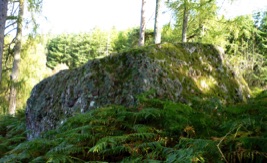

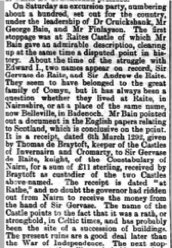
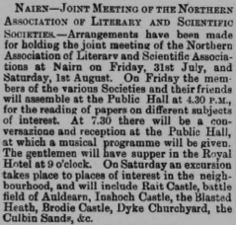



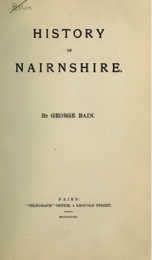
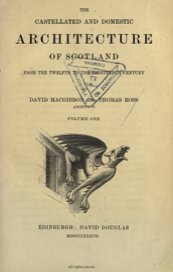
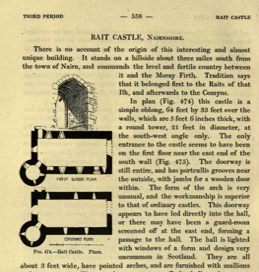
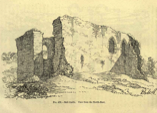
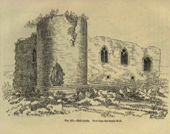
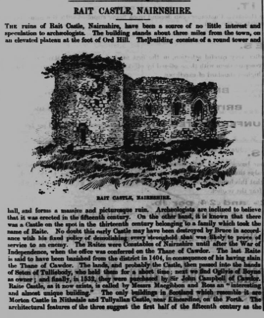

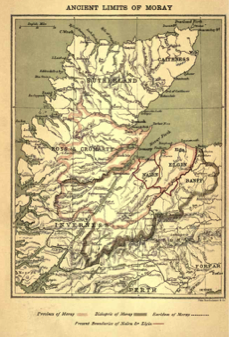
Clearly Rait Castle was well-known on the tourist circuit in the mid-19th century and the Victorians were keen on finding out more about its enigmatic history! There were more than a few references to visits to the Castle and lectures in local newspapers and they reveal that there were some discrepancies in the stories about its legend - indicating just how little was really known. On the other hand, there are some snippets of information that may have passed us by. I have gone through the local newspapers from the earliest times and have extracted all the relevant details I can find (excluding the many news items relating to Rait Castle Farm and the sales of livestock and produce there and the election of the tenants to various committees etc), and these are given below. One thing that is interesting to note is how the names of the various newspapers have changed over the years - either folded or merged with others.
The earliest mention of Rait Castle in the press seems to be in the Forres Elgin and Nairn Gazette, Northern Review and Advertiser for 6 August 1850. Under the heading Jaunts to Cawdor Castle and Inverness, there is the following: "Mr Editor, - Your liking for "Rural Rambles," and "Travels," and "Picturesque Tours," may prepare me for a favourable reception to a paper which I shall, for want of a more suitable cognomen, entitle a "Jaunt to Cawdor Castle and Inverness". Now, Mr Editor, remember this is no fancy or imaginary jaunt, not a bit of it....... Onwards we were driven, and passed the old Chapel of Geddes, in the sacred mould of which repose the mortal remains of twenty generations of the Roses of Kilravock. Shortly we reached the rising ground, and observed at some distance the delapidated (sic) castle of Rait - cowering in the skirt of a bleak hill - the scene of bloody doings in the age of chivalry, but more latterly consecrated to the loves of the young heir of Kilravock and his winsome bride, the daughter of Sir Colin and Lady Campbell of Cawdor.* Here we obtained an extensive view of the country eastward, including the cultivated estate of Lethen, to the Arr, and westward until the serrated outline of the distant highland hills almost melted away in the mist."
* There is a footnote at the bottom of the lengthy article which states that "In October 1681, Hugh Rose, yr. of Kilravock, when about 20 years of age, married the eldest daughter of the Laird of Calder. The youthful couple spent the honeymoon and resided for some time in Rait Castle. He lived to be the husband of five wives!" [If this is true, then it shows that the Castle was presumably habitable and thus not totally abandoned after the bloodbath as the legend implies."




Although Rait Castle is mentioned on more than a few websites, chiefly dealing with castles, I have thought it both interesting and useful to include a relevant "news" item posted by the very local Nairn Museum on their FaceBook page on 8 August 2020 in continuation of their theme on interesting building in Nairnshire.
Rait Castle:
Rait Castle stands a couple of miles south of Nairn at the foot of Ord Hill. Tales of romance, treachery, murder and a handless ghost haunt its ruins. It was built as a hall-house castle, and dates from the 13th century. It is unusual as it has gothic windows with red sandstone mullions (divisions between units of a window). The 9 feet high remains of the courtyard walls and remains of the Chapel of St Mary of Rait can be seen. It was originally a two story building and had an unvaulted basement and upper hall. The walls are nearly 6 feet thick. There is also a tower at one corner and the ruins of a projecting garde-robe at the north west corner. The castle originally belonged to the Comyn (or Cummings) family and they took the name of de Rait.
During the War of Independence, Sir Andrew de Rait took the side of Edward I of England while the Mackintoshes sided with Robert the Bruce. The Mackintoshes felt they rightfully owned Rait and revived their claim to it. Following several skirmishes in which the Cummings came off second best, the chief decided on a plan in which he would invite the Mackintoshes to a feast at the castle to declare a bond of friendship and bury former animosities. However, his real intention was that after the 'Toast to the Memory of the Dead' was given, the secretly armed Cummings would murder their guests. The invitation was accepted and the Mackintoshes prepared to attend. However, they were warned about Cummings' foul plot, and were prepared.
Cumming had put his household under solemn oath that they would not reveal the plot, but his daughter, who was anxious for the safety of her lover, a young Mackintosh, found a way to disclose the plot. She went to a large boulder near the castle and told the story to the stone, but she knew her lover was behind it as it was their usual meeting place. The stone to this day is known as 'The Stone of the Maiden'. The Mackintoshes resolved to attend the feast. According to Bain's History of Nairnshire, each Mackintosh hid his dirk in his plaid, and when 'the signal was given for the slaughter of the guests, the Cummings rose to draw their swords but the forearmed Mackintoshes drew their daggers and thrust them into the hearts of the Cummings'. Among the few to escape was the chief of the Cummings who suspected his daughter of the treachery. The story goes that he chased her to her bedroom where she tried to escape through the window, but he cut off her hands with his sword and she fell to her death below. Ever since then, Rait Castle has never been occupied and came into the possession of the Cawdor family in 1442. It is said that the castle is haunted by the daughter of Cummings and that she appears at dusk in a blood-stained dress, wandering aimlessly around the ruin with bloody stumps for hands.
The final verse of the poem, 'The Legend of Rait', from Nairnshire Ballads reads:
'Long ages have rolled since these curse-stricken towers
Have mouldered and crumbled, both rooftree and wall,
For lady since then hath not smiled in the bowers,
Nor warrior in wassail caroused in the hall;
But still by the fire on the lone wintery night,
With a sigh and a shudder the peasants relate
Dark legends of horror of phantom and sprite
That haunt in the darkness the Castle of Rait'
I had actually not heard of this ballad and so I asked Nairn Museum about it. They replied that they had actually come across it in an old museum folder of documents on Nairnshire castles. There was no indication of source, publication details, author, date etc. The Museum was kind enough to send me a photograph of it from the folder document.
